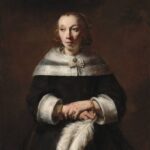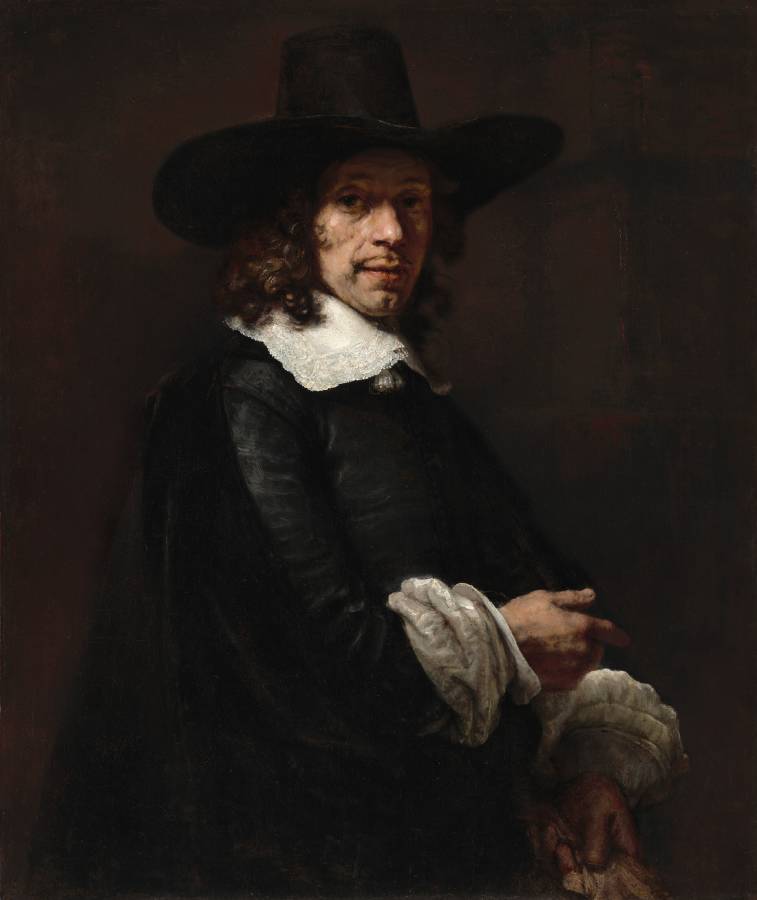Rembrandt (1606-1669)
Portrait of a Gentleman with a Tall Hat and Gloves
c.1656–1658
Oil on canvas transferred to canvas, 99.5 x 82.5 cm
National Gallery of Art, Washington
After learning the fundamentals of drawing and painting in his native Leiden, Rembrandt van Rijn went to Amsterdam in 1624 to study for six months with Pieter Lastman (1583–1633), a famous history painter. Upon completion of his training Rembrandt returned to Leiden. Around 1632 he moved to Amsterdam, quickly establishing himself as the town’s leading artist, specializing in history paintings and portraiture. He received many commissions and attracted a number of students who came to learn his method of painting. Rembrandt conceived this portrait of a man and another of a woman (see NGA 1942.9.68) as pendants, or companion pieces. In both, light illuminates the subjects from exactly the same angle. The sitters interact with restrained yet poignant warmth; he gestures toward her while looking at the viewer, and she glances in his direction while holding her feather fan so that it inclines toward him. The identity of the sitters is not known, but the circle of wealthy friends and acquaintances who might have ordered portraits at that period of Rembrandt’s life was rather small. The style of the sitters’ costumes is datable to the late 1650s, which is consistent with the character of Rembrandt’s painting technique. The early history of these paintings is shrouded in mystery, but by 1803 they had entered the collection of Prince Nicolai Yusupov (1751–1831) in Saint Petersburg. The first published descriptions of the pair, in 1864, already mention their “extraordinary energy,” and the paintings made a tremendous impression at the great Rembrandt exhibition in Amsterdam in 1898. When Nicolai’s great-great-grandson, Prince Felix Yusupov (1887–1967), escaped Russia at the start of the Revolution in 1917, he brought the family jewels and these two Rembrandt paintings with him to London. Joseph E. Widener, the future benefactor of the National Gallery of Art, purchased the pair in 1921 when the prince’s need for cash forced him to part with his family heirlooms. Shown from the hips up, a man with pale, peachy skin, dressed in a black suit and tall hat, looks at us from in front of a dark brown background in this vertical portrait painting. The man’s body is angled to our right, almost in profile, but he turns his head to look at us from the corners of his eyes under lifted brows. He has rounded nose, a thin mustache over wide, pink lips, and a deep cleft in his chin. His face is fleshy under his eyes and along his jawline, and he has a slight double chin. The wide brim of his tall black hat casts a shadow across his eyes. Shoulder-length, brown, curly hair falls on a wide, lace-edged bright white collar, which lies flat across his chest and shoulders. Light glints off his black jacket, suggesting a sheen. Wide white, disk-like cuffs encircle his wrists over puffs of voluminous white sleeves that gather on his forearms. A black, velvety cape drapes from the shoulder closer to us and down across his waist. He points to our right with his right arm, closer to us. The fawn-brown glove or pair of gloves he holds in his other hand by his far hip is cut off by the bottom edge of the canvas. (NGA)
Companion:
 Rembrandt (1606-1669)
Rembrandt (1606-1669)
Portrait of a Lady with an Ostrich-Feather Fan
c.1656–1658
National Gallery of Art, Washington
